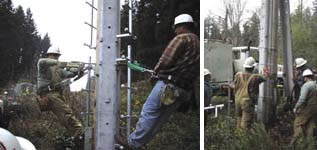Deregulation within the Electric Utility Industry is forcing many companies to stretch the capacities of their mature transmission lines. No longer are companies in control of new generation locations or capacities and their mission has changed from supplying electricity to regional customer to that of the movement of power over their grid. Once the RTO’s (Regional Transmission Operators) are in place, there will be even more pressure to maximize or increase the thermal capacity of existing transmission lines to optimize or increase profit potentials. The actual cost of line outages for maintenance of rebuild work will make many present day work procedures obsolete. Thus, the industry is changing to methods of safely increasing the existing structure heights without removing the line from service.
Several factors have contributed to Electric Utilities finding themselves with a need to increase structure height on their transmission systems. System Age – Nearly 50% of the U.S. transmission grid line miles are presently operating past the original design life. New Merchant Power Plants – The addition of new deregulated merchant power plants continually change the electrical loading on grids. Increased System Loads – For more than a decade, the North American economy grew at a non-stop rate. At the same time Electric Utilities have tried to optimize their grid resources. Electrical Deregulation – Electric Utility deregulation has inspired the creation of RTO, TRANSCO or ISO organizations to maximize the capacity of regional grids to meet present day and future demands. Factors that are being addressed are structural stability and thermal capacity of the grid. Under these new operating conditions, there maybe a substantial cost of $5,000 to $100,000 per hour for having the line removed from service. This may make conventional methods of structure upgrading obsolete. Limited Right-of-way for New Lines – Electric Utilities have been forced to increase structure height and strength to facilitate the addition of a circuit or an under-build. The addition of telecommunication cables can also necessitate the need for a taller and/or stronger transmission structure.
The need for increased groundline clearance and capacity, coupled with the constraints upon utilities to severely limit outages during line maintenance, has fostered the development of a new structure lifting system by Laminated Wood Systems, Inc (Seward, NE USA).
Many utilities in the US and Canada have implemented this structure lifting system to safely raise their transmission lines without taking them out of service. One such utility is Central Maine Power who found themselves having to accept an additional 1600 MW of power from five new merchant plants which were built in its territory. The utility was first informed of the increased load in 1999 and was required to have a solution in place by May, 2000.
Of the options considered, raising the structures held the most promise of accomplishing the upgrade. Structure change-outs would be very costly and require the line to be taken out of service, which was not an option. The original scope of the project was thought to involve only 67 345kV
H-frame structures but by the time the project was completed 270 structures had been raised an additional 5, 10 and 15 feet in height in just four months. CMP elected to contract the structure lifting project to On Target Utility Services who received initial training from LWS using the specialized tools and equipment trailer. Three six man crews were able to complete the challenging project within the deadline imposed upon them by CMP. The utility estimated that by raising the structures they realized a minimum of twenty million dollars in cost savings since the line was kept in service during the upgrade.
Public Service Company of New Mexico also found themselves in a situation where more than 300 miles of 345kV K-frame line would be accepting an increased load from 1600 amps to 2016 amps and 170 miles of 230kV would be increasing its load from 800 amps to 1004 amps. The project required raising more than 300 structures an additional 3, 6 and 12 feet prior to the summer peak load demand. It was determined that the cost of changing out the affected structures would be an estimated $30,000 per structure. Installing taller poles on existing structures would cost approximately $15,000 per structure and to re-sag the short sections would cost $25,000 each. Raising the structures came in as the lowest cost solution at approximately $6,500 per structure.
The patented structure lifting system (PhaseRaiser) utilizes steel members that are either placed or driven on each side of the pole, depending on the strength of the existing structure. Initial cuts are made in the pole prior to placement of the steel and after the bottom of the steel members has been secured with cross bolts to the pole, the pole is then cut clear through, separating the pole butt from the rest of the structure. Specialized straps temporarily secure the steel to the poles above the cut. Hydraulic cylinders are then attached to vangs that have been secured on the pole butt and upper structure. The cylinders then raise the structure to the desired height and the steel members are permanently secured to the structure using cross bolts. The straps, cylinders and vangs are removed and the exposed portions of the pole are treated with a preservative. The gap created by the lift is then covered with steel covers and the process is complete. LWS provides training for crews and the specialized tools and equipment trailer can be rented or purchased. In addition to the specialized tools, crews need only basic items such as a chainsaw, drill and impact guns.
This new structure lifting system appears to be one of the more innovative products to hit the electric utility market in years and could prove to have widespread application in solving groundline clearance issues for utilities.

Several factors have contributed to Electric Utilities finding themselves with a need to increase structure height on their transmission systems. System Age – Nearly 50% of the U.S. transmission grid line miles are presently operating past the original design life. New Merchant Power Plants – The addition of new deregulated merchant power plants continually change the electrical loading on grids. Increased System Loads – For more than a decade, the North American economy grew at a non-stop rate. At the same time Electric Utilities have tried to optimize their grid resources. Electrical Deregulation – Electric Utility deregulation has inspired the creation of RTO, TRANSCO or ISO organizations to maximize the capacity of regional grids to meet present day and future demands. Factors that are being addressed are structural stability and thermal capacity of the grid. Under these new operating conditions, there maybe a substantial cost of $5,000 to $100,000 per hour for having the line removed from service. This may make conventional methods of structure upgrading obsolete. Limited Right-of-way for New Lines – Electric Utilities have been forced to increase structure height and strength to facilitate the addition of a circuit or an under-build. The addition of telecommunication cables can also necessitate the need for a taller and/or stronger transmission structure.
The need for increased groundline clearance and capacity, coupled with the constraints upon utilities to severely limit outages during line maintenance, has fostered the development of a new structure lifting system by Laminated Wood Systems, Inc (Seward, NE USA).
Many utilities in the US and Canada have implemented this structure lifting system to safely raise their transmission lines without taking them out of service. One such utility is Central Maine Power who found themselves having to accept an additional 1600 MW of power from five new merchant plants which were built in its territory. The utility was first informed of the increased load in 1999 and was required to have a solution in place by May, 2000.

Of the options considered, raising the structures held the most promise of accomplishing the upgrade. Structure change-outs would be very costly and require the line to be taken out of service, which was not an option. The original scope of the project was thought to involve only 67 345kV
H-frame structures but by the time the project was completed 270 structures had been raised an additional 5, 10 and 15 feet in height in just four months. CMP elected to contract the structure lifting project to On Target Utility Services who received initial training from LWS using the specialized tools and equipment trailer. Three six man crews were able to complete the challenging project within the deadline imposed upon them by CMP. The utility estimated that by raising the structures they realized a minimum of twenty million dollars in cost savings since the line was kept in service during the upgrade.
Public Service Company of New Mexico also found themselves in a situation where more than 300 miles of 345kV K-frame line would be accepting an increased load from 1600 amps to 2016 amps and 170 miles of 230kV would be increasing its load from 800 amps to 1004 amps. The project required raising more than 300 structures an additional 3, 6 and 12 feet prior to the summer peak load demand. It was determined that the cost of changing out the affected structures would be an estimated $30,000 per structure. Installing taller poles on existing structures would cost approximately $15,000 per structure and to re-sag the short sections would cost $25,000 each. Raising the structures came in as the lowest cost solution at approximately $6,500 per structure.
The patented structure lifting system (PhaseRaiser) utilizes steel members that are either placed or driven on each side of the pole, depending on the strength of the existing structure. Initial cuts are made in the pole prior to placement of the steel and after the bottom of the steel members has been secured with cross bolts to the pole, the pole is then cut clear through, separating the pole butt from the rest of the structure. Specialized straps temporarily secure the steel to the poles above the cut. Hydraulic cylinders are then attached to vangs that have been secured on the pole butt and upper structure. The cylinders then raise the structure to the desired height and the steel members are permanently secured to the structure using cross bolts. The straps, cylinders and vangs are removed and the exposed portions of the pole are treated with a preservative. The gap created by the lift is then covered with steel covers and the process is complete. LWS provides training for crews and the specialized tools and equipment trailer can be rented or purchased. In addition to the specialized tools, crews need only basic items such as a chainsaw, drill and impact guns.
This new structure lifting system appears to be one of the more innovative products to hit the electric utility market in years and could prove to have widespread application in solving groundline clearance issues for utilities.








